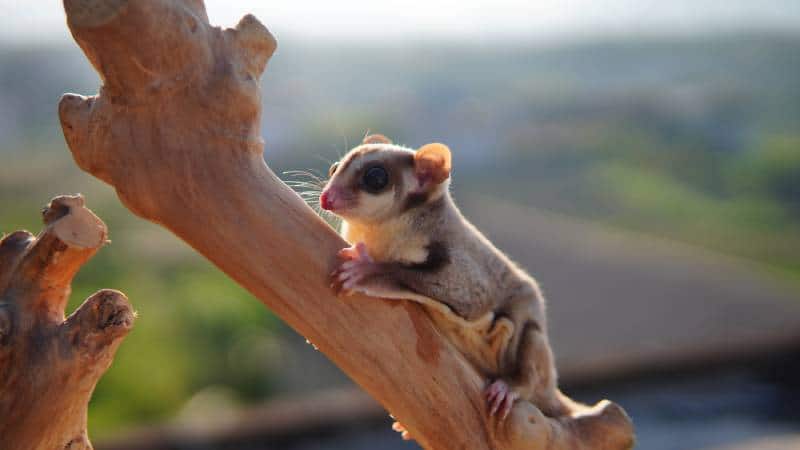The ability to “fly” or glide when they spread out in this parachute fashion is similar to the ability of the Flying Squirrel. But other than that, they are very different animals than the Flying Squirrel.
Sugar gliders are small, attractive, and interesting little animals. Though they sleep during the day, once they wake up in the evening they are very social, lively and active little pets.
Sugar gliders can make great companions and provide a lot of interaction and enjoyment to their owners. With enough loving care and attention they can form lifelong bonds with people.
When considering purchasing a sugar glider as your new pet, make sure you are ready for the commitment of time and care that it will need. This little animal can live up to 15 years if you take good care of him.
| What’s in the name ? | ||
|---|---|---|
| Belonging to the group: phalanger | means | “fingery-one” |
| Genus: Petaurus | means | “tightrope walker” or “rope dancer” |
| Species: Breviceps | means | “short head “ |
- For information about Small Animals and their care visit: Guide to a Happy, Healthy Small Animal
Scientific Classification
| Kingdom: | Animalia |
| Phylum: | Chordata |
| Class: | Mammalia |
| Order: | Diprotodontia |
| Family: | Petauridae |
| Genus: | Petaurus |
| Species: | breviceps |
Scientific Name
Petaurus breviceps
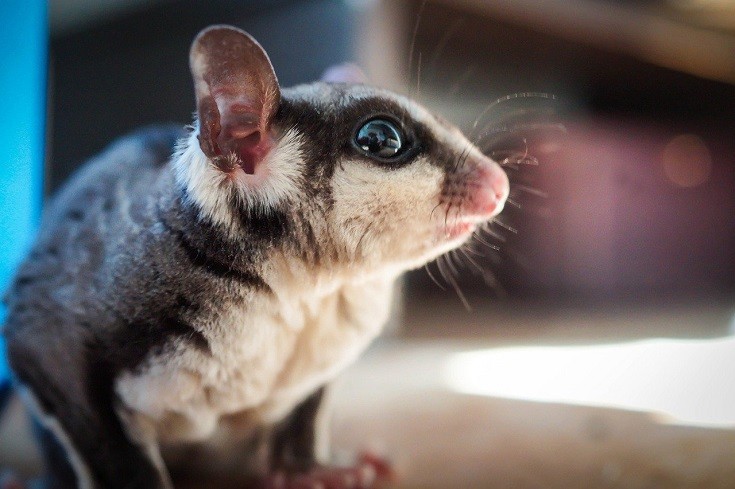
Background
Sugar gliders are small possums found in Australia, Tasmania, Indonesia, and Papua-New Guinea
. They are mammals classified as marsupials. Marsupials differ from other mammals in that they have a very short placenta gestation period. Most marsupials give birth after a very short time and then continue to nurture their young in pouches until they are old enough to come out. They also have more teeth than placental mammals, and have a lower body temperature (around 89 degrees Fahrenheit).
Note: Possums are NOT the same thing as opossums. “Opossums” range from North America to southern Argentina and contain 15 genera with over 60 species. “Possums” are found in Australia with over 20 species. They are both marsupials, but are actually only distantly related within the same subclass.
Description
Sugar gliders are only about 5 to 6 inches long (from the tip of the nose to the base of the tail), with another 5 or 6 inches of tail length. They only weigh between 3.4 and 5.5 ounces. Males typically weigh slightly more than females.
They have a membrane flap of skin stretching from their forefeet to their hind feet called a patagium. It is furred and helps the sugar glider fly through the air by catching the air and helping him stay afloat for a short period of time.
Sugar gliders are gray with a cream colored underbelly and a black stripe down their backs.
Environment
Sugar gliders need an adequate size cage – at least 20 x 20 x 30 inches. A taller cage is better than a wider one because sugar gliders love to climb. Wire cages are best and commercial bird cages work well. You don’t want to use screen door mesh wire, as this is too small and your pet can easily get his claws caught in it. Cages with removable trays are also very handy, because they are easy to clean.
Keep the cage where your sugar glider won’t experience large differences in temperature (usually the best place is indoors). Since they are nocturnal, sleeping during the day, you will want to put the cage somewhere out of the way where it won’t be disturbed by people’s daily comings and goings. But do make sure to keep him where he can see whether it is night or day, so as to not mess up his biological clock.
Inside the cage provide a nesting box where your sugar glider can sleep during the day. Put aspen shavings, shredded paper, or an old cloth in the nesting box for more comfortable sleep. Put shavings on the bottom of the cage also, to absorb droppings and pushed out food. DO NOT use cedar shavings – these can cause respiratory problems. It is also thought that pine bedding may cause problems as well.
To make your sugar glider’s habitat more natural, it is a great idea to put branches in the cage (many bird perches work great, also). Just be sure that the branches you use are clean and don’t have any chemical residues left on them.
Including toys in the cage will give your pet exercise and enjoyment. Many bird toys work great, and also hollow logs or pipes that they can explore and hide in.
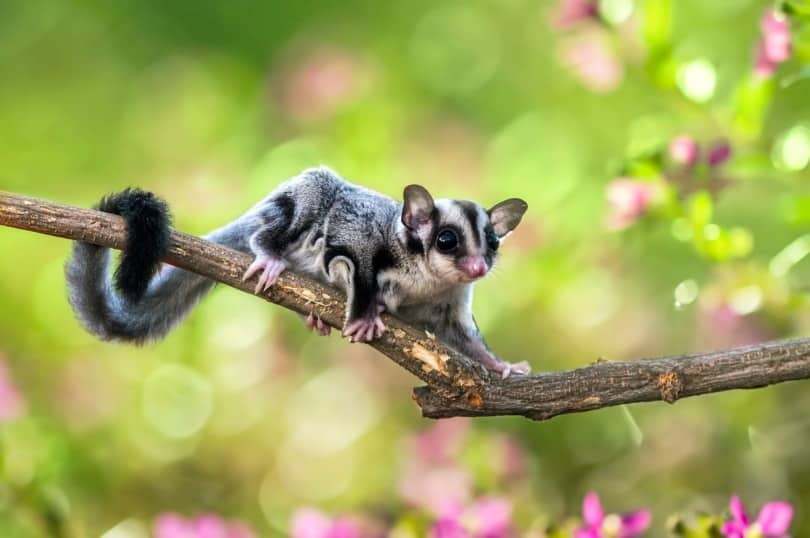
Care and feeding
Sugar gliders need a large variety of food in captivity including fruits, vegetables, protein, and dairy products.
A good food dish can be a heavy bowl (such as ceramic) so that it does not get tipped over, or even a bird dish that clips onto the side of the cage. Place the dish up high in the cage because this is where sugar gliders feel most comfortable. To know how much to feed, experiment starting with a small amount one evening, and if all the food is gone in the morning, then give him a little more the next evening. Continue doing this until there is a little bit of food left over one morning. In general, there should be about a 3 to 1 ratio of fruits and vegetables to proteins. Food dishes should be cleaned and sanitized daily.
Sugar gliders will eat just about any fruits or vegetables, including: apples, oranges, cantaloupe, carrots, peas, and beans. They do tend to like the sweeter greens (hence the name “sugar” glider). All fruits and vegetables should be fresh and rinsed – they should not be canned or dried.
Feed them a variety of fresh greens; it is best to do it in the evenings so that they have food ready for them when they wake up. Remove any uneaten fresh food the next morning so it does not go bad.
For proteins sugar gliders like meats, eggs, and tofu. Any meat you feed them should be thoroughly cooked and cut up into very small pieces. The meat should not contain any skin or bones, either. Hard boiled eggs are also a good choice of protein, cut or mash them up to make them easier for your glider to eat. Tofu is one of the best proteins to feed to sugar gliders, however many gliders don’t like it by itself. Try cutting it into tiny pieces and mixing it with a little yogurt or one of it’s favorite fruits.
Dairy products are another good source of protein for your sugar gliders. Yogurt and cottage cheese work well. Dry cat food as a supplement for protein can be used on occasion, but it should not be an all the time thing – for there is concern that this can cause ill health effects. Nuts, such as peanuts, sunflower seeds, and pecans are also a dearly loved treat for sugar gliders.
Sugar gliders also LOVE live food, since that is their primary source of protein in their natural habitat. These can include crickets, grasshoppers, mealworms, and even baby mice (pinkies), or young adult mice. Usually, all these live foods can be obtained at a pet store – either live or frozen.
The other big thing is water – even though many of the fruits and vegetables contain much of the water sugar gliders need, it is still mandatory to make sure sugar gliders must have access to water at all times. Put water in a heavy dish or in a water bottle attached to the side of the cage. If you choose to use a water bottle, continue putting a dish of water in the cage until you are sure he knows where the water bottle is and is using it. Water also should be kept up high in the cage. Rinse out water bottles once a day.
Giving sugar gliders vitamin supplements can also serve to make sure they are getting all their nutrients. Usually the biggest problem is calcium. Good calcium supplements are things like Reptivite and Rep-Cal (reptile vitamins).
Social Behaviors
Sugar gliders are very social creatures and love to be part of a group. They will usually get along with any other sugar gliders. Two or more females or males work well, but if you put mix the two genders this could very easily result in offspring. Use caution when first introducing new sugar gliders to each other. Watch them carefully just to make sure they get along before you leave them totally unsupervised.
As a general rule, sugar gliders and other pets do not mix. They should definitely be kept away from large birds and housed in completely different rooms. This is because birds are their natural predators and will stress them out if kept around them. Watch out for dogs and cats as well – some of them may think they are play toys or food. Even if they seem to get along fine, make sure to still supervise them when they are together outside of the cage. Sugar gliders and other exotic pets such as flying squirrels should NOT be kept together. They will stress each other out and may kill each other.
Young children should have supervision when playing with these pets, as sugar gliders need to be handled gently and require a lot of patience.
Handling and Training
Sugar gliders definitely need time in getting used to their new owners. Therefore, don’t rush him or scare him unnecessarily by grabbing him quickly and unexpectedly. First handle your new sugar glider a couple days after you’ve brought him home, preferably in the daytime when he’s sleepy as this will make him easier to handle. Always pick him up gently with a cupped hand and support his entire body.
One thing sugar gliders are very good at is gliding – which is why they have their kite type furry membrane. Training them to glide to you is probably the best trick they can learn. To do this, put him up somewhere high, where he would have to glide in order to get down. Start by putting a treat in your hand and putting it close to your sugar glider, so that he steps into your hand to get it. Continue doing this, but gradually move your hand further and further away so that he has to start making short leaps, and then eventually has to glide to you in order to get his treat.
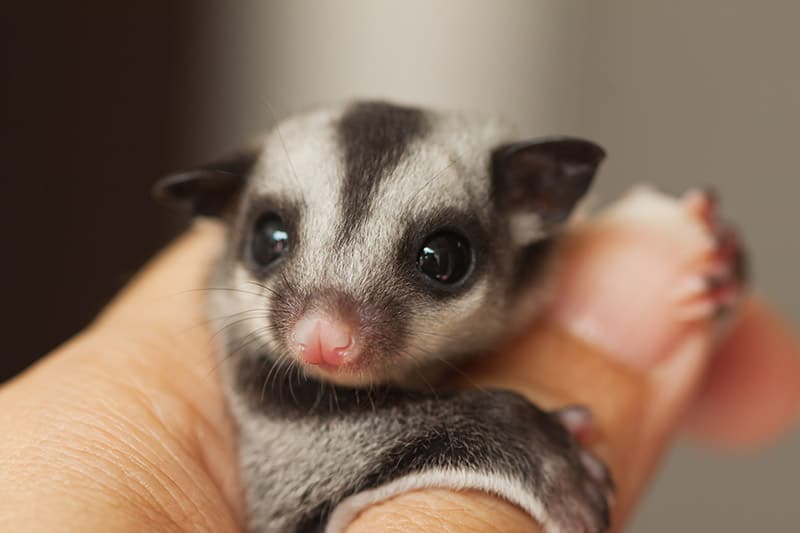
Activities – Exercise and Play
Sugar gliders are nocturnal, but once they wake up for the night, they love to get up to play and exercise. If they are tame, it is a great idea to let them out of their cage for a few hours so they can explore. There are many potential hazards they could get themselves into so don’t leave them unsupervised. Things such as refrigerators, stoves, toilets, windows, and poisonous plants can all hurt or kill your pet if you aren’t careful.
Taking your sugar glider outside is another consideration. Only do this when it is cloudy or the sun is mostly down, so as not to hurt your pet’s nocturnal eyes. You also shouldn’t take him outside unless you are positive that you can control him (meaning he is definitely bonded to you). You might want to try putting him on a leash and harness to have some extra security that he won’t get away from you. Also keep him away from trees, since sugar gliders love to be up high, and it is very likely that he will try to leave you in order to go to the top of the tree.
Breeding/Reproduction
Before deciding to breed sugar gliders, make sure you are ready for the time and commitment it takes to raise, care for, and re-locate the young. Many states also require a breeding license for sugar gliders, so you’ll have to check with the USDA (United States Department of Agriculture) office in your area to determine whether you need one or not.
You’ll need to have the appropriate size cage (the more sugar gliders the larger it needs to be), and provide large nesting boxes.
Sugar gliders mate all year round, with a females estrous cycle lasting 29 days each time. They are not sexually mature for at least 8 to 14 months, however, they will not breed younger than that, so it is safe to place young females and males together.
There are some definite noticeable physical differences between male and female sugar gliders. Females have a pouch opening in their abdomens, and have no visible scent glands. Males have a furred scrotum on their lower abdomens, and two visible scent glands. One of them is a bald spot on their head, and the other gland is on their chest.
Sugar gliders can produce about 2 or 3 litters a year. Litter sizes are 1 to 4 babies, but the usually is 2. During mating, the male will grab the fur on the females back to hold her still. The gestation period is only 16 days for sugar gliders, and the babies (called joeys) are born blind and deaf, weighing only 0.007 ounces.
The newborn babies will make their way to the mother’s pouch by pure instinct. There are 4 nipples in the mother’s pouch and the joeys will grab one of them. There they will remain in the pouch for about 2 months and then emerge from the pouch fully furred.
When they emerge from the pouch they will ride on the back of either the mother or the father, only sticking their heads back in the pouch to nurse. It is perfectly fine and normal to keep the female and male together after mating. The joeys eyes will open about 7 to 10 days later and they will be completely weaned by 5 months of age.
Once the joey’s eyes open, you can start handling them for short periods of time to get them used to your scent and to tame them. Weaning occurs about 3 to 4 weeks after they open their eyes. Start offering them plenty of fresh fruits and vegetables for them to try out.
Ailments/Treatments
As with all animals, sugar gliders can become ill. But you can do your best to avoid this by taking good care of your pet. Make sure he gets proper nutrition, a stress-free environment, and a clean cage. This will keep your sugar glider in the best of conditions and reduce the chances of him getting sick.
Signs that indicate your sugar glider may not be feeling well include: watery eyes, listless attitude, red and scaly skin, abscesses, vomiting, unnatural feces, balding, weight loss, and labored breathing.
Calcium deficiency
This is the most common problem for sugar gliders. Indications that this may be the problem with your pet include lameness, paralysis, and difficulty moving. Insufficient calcium makes their weaker and more prone to break.
Usually, the cause of this is that there is much more phosphorus in the diet compared to calcium, which reduces the bodies ability to absorb calcium. Try feeding foods that don’t have as much phosphorus in them. Good foods for this include cherries, figs, pink grapefruit, mangos, oranges, papaya, pears, pineapples, raspberries, tofu, and yogurt.
Giving calcium supplements while your glider is sick is also a good idea. Take him to the veterinarian if he appears to be really sick or paralyzed because this is probably the best way to make sure he becomes healthy again.
Diarrhea
This can be indicated if your sugar glider has watery droppings and can be caused by several different things, including feeding too much citrus fruits, lactose intolerance, gastroenteritis, toxin intake, or stress. As soon as you notice diarrhea, stop feeding him foods that contain the above ingredients. If it doesn’t appear to be getting any better after a day or so, taking your glider to the vet is the best option.
Constipation
If it appears that your sugar glider is constipated and has an extended abdomen, it is an indication that there is an insufficient amount of roughage in their diet or that they are eating too much dry food. The best way to remedy this is to change their diet to make sure they are getting plenty of water and to stop feeding really dry foods (such as cat food).
Internal and External Parasites
Internal parasites include roundworms, hookworms, and tapeworms. External parasites include mites, lice, fleas, and ticks, which are parasites that live on the skin. Treatments for this can be injections (such as Ivermectin), and powders and sprays. Powders and sprays may not be the best option however, because they sometimes interfere with sugar gliders sense of smell and stress them out. Check with your vet to determine the best treatment method, and make sure the keep the entire living area clean and disinfected.
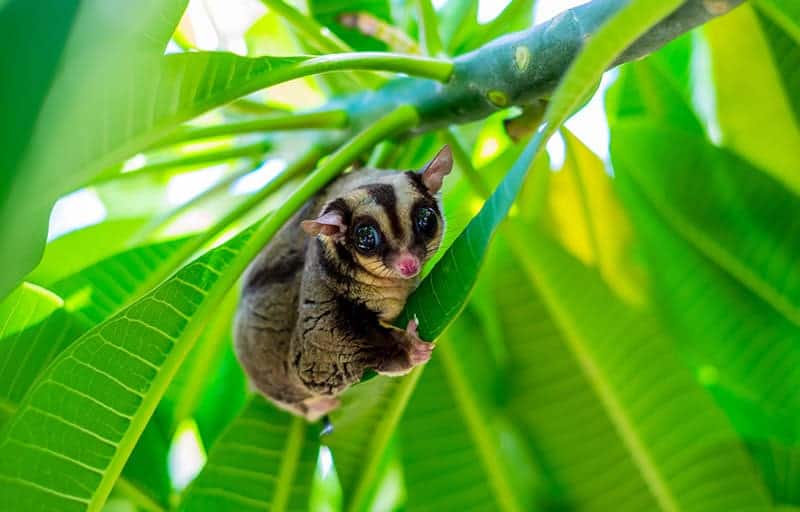
Availability/Purchasing your Sugar Glider
Find a reputable breeder or retailer to purchase from. A local supplier is best so that you can see and handle firsthand the sugar glider(s) you want to purchase. It will be less stressful on the animal if he is not shipped.
It is best to get one that is fairly young – better yet to get one that has just been weaned so you can start your bonding experience early. Weaning is usually 12 or 13 weeks after their original birth date, and 4 or 5 weeks after they have emerged from the pouch. Make sure to ask how long it’s eyes have been open – they should have been open for at least 4 to 6 weeks before you purchase it.
Whether you get a male or female sugar glider is totally up to preference – they will both usually make great pets and don’t differ much in behavior patterns. Also, consider whether you only want one sugar glider, or if you would like more than one. They are very social animals and love company, so if you don’t think you’ll have an abundance of time to give to your pet, you may want to get more than one. Usually sugar gliders will get along with each other – no matter what their gender. So feel free to purchase 2 females or 2 males. Don’t buy a pair though, unless you want babies.
Look for signs that indicate a healthy sugar glider. It should have bright and clear eyes with no discharge, clear nose, a soft, thick, clean coat, and have a good healthy weight. Observe him in his cage and check for alertness and free movement on his part. Ask to see the sugar glider handled so you can see if he has a good disposition with people, and if possible handle him yourself for a while.
Another thing to take into consideration before you decide to purchase your sugar glider is does your veterinarian treat exotic pets? Not all vets do, so you might want to check and make sure that there is a vet in your area that will treat your pet in case he gets sick.
Featured Image Credit: ariffurqon12, Shutterstock
